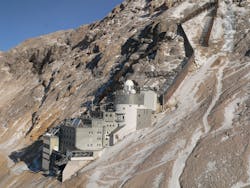OPTICAL PARAMETRIC OSCILLATORS: DIAL in the Alps measures tropospheric water vapor
Water vapor accounts for somewhere around two-thirds of the overall greenhouse effect in Earth’s atmosphere; thus, accurate information on the distribution of water vapor in the atmosphere is crucial for models of Earth’s climate. In particular, more accurate knowledge of the vertical distribution of water vapor in the upper troposphere, which radiates longwave-infrared radiation into space, is needed.
High in the German Alps, at the Environmental Research Station Schneefernerhaus (Umweltforschungsstation Schneefernerhaus, or UFS), the researchers Hannes Vogelmann and Thomas Trickl (Karlsruher Institut für Technologie) have developed a high-power differential-absorption lidar (DIAL) that can measure the vertical distribution of water vapor in the free troposphere (3 to 12 km above sea level; the free troposphere is the portion of the troposphere above by the temperature-inversion layer at approximately 2 km above sea level).1 After an extended testing period, full routine operation started in 2007.
The Schneefernerhaus, sited at almost 2700 m near the summit of the Zugspitze—Germany’s highest mountain—was built in 1930 as a hotel and access point to the ski area. After 1990, it was converted to a center for atmospheric, geophysical, and medical research. The building is accessible by cable car or cogwheel train.
Two alternating wavelengths
The DIAL system emits narrowband light at two closely spaced wavelengths next to 817 nm, within a weak absorption band of water vapor: One of the wavelengths falls within the absorption line chosen, while the other one does not. Intense pulses are sent up into the sky, alternating in these two wavelengths. The backscattered light for both wavelengths is collected, recorded as a function of the light travel time, and integrated over several thousand pulses. From the differential absorption retrieved from both signals, the vertical distribution of water vapor is calculated. The researchers note that their system is fully capable of daytime measurements, unlike Raman lidar techniques.
In the laser system, two singlemode optical parametric oscillators (OPOs) sequentially seed a flashlamp-pumped Ti:sapphire ring laser. The output wavelength of the OPO is tunable from 700 to more than 1000 nm with a wavelength stability of +/-35 MHz; the OPO emits transform-limited 2 ns pulses and has a spectral purity better than 99.9%. After amplification in the Ti:sapphire laser, the pulse energy is 250 mJ at 800 nm and will eventually be increased to 700 mJ.
The OPOs were recently successfully pumped at a substantially higher repetition rate of 100 Hz with a diode-pumped solid-state (DPSS) laser from InnoLas (Krailling, Germany), the SpitLight DPSS 250 Nd:YAG laser, which will now be used in the system. This laser is injection seeded and can produce 250 mJ pulses at 1064 nm and 125 mJ pulses at 532 nm.
A Newtonian telescope with a 0.65 m aperture collects the backscattered light, which is filtered by narrowband filters (5 nm and 0.5 nm) to block background daylight. Because the return signal has a large five-decade dynamic range, the collected light is split into near- and far-field channels before detection by avalanche photodiodes and digitized at a range resolution of 7.5 m.
The researchers note that the UFS site on the Zugspitze is mostly above the Earth’s moist boundary layer, enabling measurement of the free troposphere with reduced interference extended range. The resulting data have a measurement error that is usually less than 5% and a bias of 1% or less.2
REFERENCES
1. H. Vogelmann and T. Trickl, Appl. Opt., 47, 2116-2132 (2008).
2. H. Vogelmann, R. Sussmann, T. Trickl, and T. Borsdorff, Atmos. Meas. Technol., 4, 835-841 (2011).

John Wallace | Senior Technical Editor (1998-2022)
John Wallace was with Laser Focus World for nearly 25 years, retiring in late June 2022. He obtained a bachelor's degree in mechanical engineering and physics at Rutgers University and a master's in optical engineering at the University of Rochester. Before becoming an editor, John worked as an engineer at RCA, Exxon, Eastman Kodak, and GCA Corporation.
